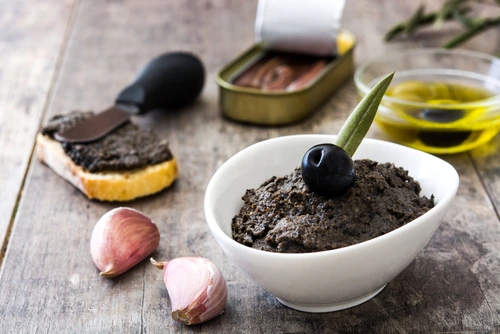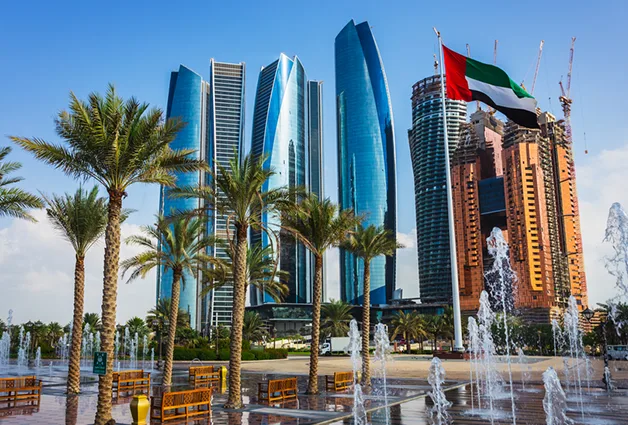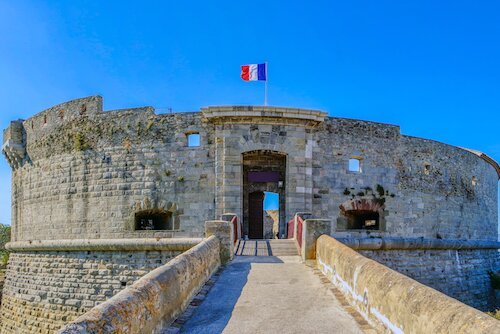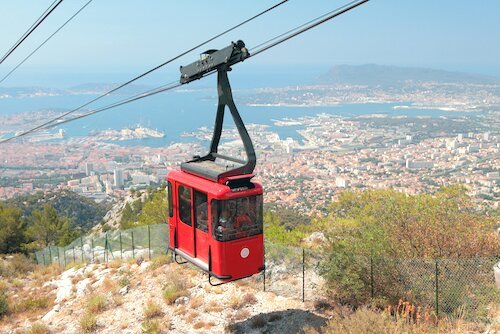Mont Faron

The 584 m high Mont Faron is the most famous landmark in the city and provides a beautiful backdrop. If want to shake off calories from the French cuisine you’ve been enjoying, take on the challenging walk up the west side of the mountain.
The road was part of the route used in the discontinued Tour Méditerranéen bicycle race. It was considered to be one of the most difficult parts of the route.
If you don’t like your chances of hiking to the peak, the best way to get to the top is via the Téléphérique du Faron cable car. In addition to saving your energy for other parts of the city, the cable car provides wonderful views of the Bay of Toulon.
Once you arrive at the peak, treat yourself to a meal at one of the restaurants, where you can enjoy views of the harbor while you eat. Before you leave, consider picking up a few gift items at the cable car shop.
Mémorial du Débarquement

Mémorial du Débarquement is a World War II military museum/memorial at the top of Mont Faron. Opened in 1964, the museum has artifacts and exhibits from the events during the 1944 allied landing between Toulon and Cannes.
In addition to reflecting on the D-Day landings, the location's elevation offers views of Toulon, the cities around it, and the Mediterranean Sea. It is the perfect destination for anyone curious to learn more about D-Day or people with a family member who fought in World War II.
Circuit Paul Ricard

True racing fans can rent the Circuit Paul Ricard track for an exciting track day event. Businessman Paul Louis Marius Ricard built it in 1969. Famous for its iconic blue run-off areas known as the Blue Zone, the circuit is just a 30-minute drive from Toulon. Back in the 1980s, the track saw a lot of prime motorsport action as it hosted numerous Formula One pre-season tests and races. Local F1 hero Alain Prost won three French Grand Prix races at the Paul Ricard Circuit during that period.
Other events held here include motorcycle and GT car races. Time your visit right, and you can take advantage of driving experiences offered by different providers at the circuit.
AGS Formule 1
AGS (Automobiles Gonfaronnaises Sportives) ran a Formula 1 team from 1986 to 1991. Now, the company offers driving courses available to racing fans. Fans can participate in several driving courses and feel the power of real Formula One cars. AGS offers half-day and full-day driving courses, allowing attendees to select their preferred open-wheel racecar.
The driving courses take place at either the Circuit Paul Ricard or the Circuit du Luc-en-Provence. Each location offers attendees an exciting driving course with one of the best driving experiences in the south of France.
Plages du Mourillon (Beaches of Mourillon)

Plages du Mourillon is a set of European Blue Flag beaches that attract locals and tourists seeking a perfect Mediterranean escape. These family-friendly beaches are just a short distance from the city center. They offer stunning views of the Mediterranean Sea and a peaceful atmosphere.
The area is well-maintained, with four distinct beaches separated by grassy lawns. Visitors can swim in crystal-clear waters, sunbathe on the soft sand, or take part in water sports.
In addition to its natural beauty, Plages du Mourillon offers a variety of amenities to ensure a comfortable visit. Plenty of seaside restaurants and cafés serve fresh seafood and local French cuisine. Families with children will like the playgrounds and the calm, shallow waters, perfect for young swimmers.
Toulon Old Town

The city's Old Town has beautiful southern French architecture and charm. Visitors will find narrow cobblestone streets in the Old Town. They are fantastic to explore, and visitors will find many cafes, restaurants, and shops here. You'll also find the city's tiny artisan shops where you can purchase gift items.
Opera lovers should look out for Opéra de Toulon, located on Boulevard de Strasbourg on the boundary of the the Old Town. It is France's second-largest opera house after Palais Garnier in Paris.
The building has a beautiful mix of Baroque and Renaissance architecture and is worth visiting even if you're not an opera fan.
Toulon Port

The Port of Toulon is the main Mediterranean base of the French navy. It won’t take long to notice this once you’re at the port. You’ll find a set of aircraft carriers, submarines, and other naval ships docked here. Anyone with an interest in battleships should add the port to their lists of places to visit.
In addition to the strong naval presence here, the port is a major docking location for large cruise ships, which are always a joy to watch. The port is close to various shops and restaurants serving tasty Mediterranean food.
Also present at the port is Musée National de la Marine, a marine museum that sums up the city’s transition to becoming the largest Mediterranean naval port. Opened in 1814, it is the oldest maritime museum in France. Exhibits include paintings, scientific instruments, and models.
While at the port, look out for Génie de la Navigation (The Genius of Navigation). It is bronze and marble statue built in 1847 to recognize the city’s sea exploration heritage. Another attraction at the port is the ferry service with trips to some of France’s most beautiful Mediterranean islands.
Sentier des Douaniers
The Sentier des Douaniers (Customs Officers' Path) is a scenic coastal trail with views of the Mediterranean. The path was once used by customs officers to monitor smugglers along the coast. Today, it serves as a popular hiking route with locals and visitors.
Winding along the rugged coastline, the 11 km trail connects coves, rocky cliffs, and sandy beaches. Hikers are treated to panoramic views of the crystal-clear waters and lush vegetation.
In addition to its scenic beauty, the trail offers a look into the region's rich maritime history. There are several historical landmarks along the path. These include old watchtowers, which add to the charm of the hike.
The trail is well-marked and accessible for hikers of all levels, with various sections offering different levels of difficulty. This makes it suitable for relaxing walks or challenging hikes.
Cours Lafayette Market

Cours Lafayette Market is a Tuesday to Sunday farmers’ market held close to the port of Toulon. Vendors at the market offer everything from flowers, fruits, and vegetables to fresh fish.
Even if you have no interest in cooking (after all, you’re on vacation), the colorful stalls and lively interactions between the vendors and their customers will likely keep you in good spirits.
With plenty of cafes and restaurants around the market, it’s the perfect place to enjoy French food. Whether you want to purchase fresh produce to create iconic French dishes yourself or sample prepared meals, this market has you covered.
One important thing to keep in mind is the market is only open in the morning, so plan well to avoid missing it.
Place De La Liberte

Place de la Liberte is a square located on Boulevard de Strasbourg. The square is lined with rows of palm trees along its borders and is surrounded by historic structures. These include the building currently housing the Théâtre Liberté.
It was built as a grand hotel in 1870 and later used by occupying forces in the Second World War. Subsequently, it was changed to an apartment building before being switched to its current use.
On the north side of the square, right next to Rue Victor Clappier, is Fontaine de la Fédération, a neoclassical white limestone fountain decorated with allegorical French figures.
Built in 1889 by brothers architect Gaudensi Allar and sculptor André-Joseph, the fountain is a symbol of unity and celebrates the centenary of the French Revolution. Also present around the square are various cafes, restaurants, and other retail outlets. If you need a break from exploring Toulon, this is the place to do it.
Compared to other nearby towns and cities, Toulon is a peaceful southern France holiday spot. It has unique tourist attractions and offers lovely beaches, beautiful views, and great Mediterranean weather.
Weather

Local Favorite: Tapenade
Tapenade was invented by Chef Meynier in 1880 at the La Maison Doree Restaurant in southern France. Since its invention, tapenade has become synonymous with the southern region of the country. Traditional tapenade is made by crushing capers and black olives. The crushed mixture is combined with anchovies and tuna before spices, pepper, and olive oil are added. Tapenade can be spread onto bread and enjoyed with a glass of wine, or as a side to a meal. It is also consumed by dipping vegetables or bread into it. Tapenade's ingredients are considered incredibly healthy resulting in the spread being labeled a so-called "superfood".












